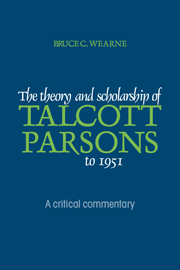Book contents
- Frontmatter
- Contents
- Preface
- Part 1 Unravelling Talcott Parsons' theoretical development
- Part 2 Talcott Parsons: the roots of his thought
- Part 3 The development of theory
- Part 4 The theory
- 7 Conceptualizing The Social System
- 8 Developing The Social System
- 9 Formulating The Social System
- 10 The Social System
- Part 5 Parsons' theory as it stood at 1951
- Appendix Some recent publishing on Talcott Parsons' theory: a bibliographical essay
- List of references
- Index of names
- Index of Parsonian concepts
9 - Formulating The Social System
Published online by Cambridge University Press: 05 February 2012
- Frontmatter
- Contents
- Preface
- Part 1 Unravelling Talcott Parsons' theoretical development
- Part 2 Talcott Parsons: the roots of his thought
- Part 3 The development of theory
- Part 4 The theory
- 7 Conceptualizing The Social System
- 8 Developing The Social System
- 9 Formulating The Social System
- 10 The Social System
- Part 5 Parsons' theory as it stood at 1951
- Appendix Some recent publishing on Talcott Parsons' theory: a bibliographical essay
- List of references
- Index of names
- Index of Parsonian concepts
Summary
Introduction
Parsons' three major statements about theory in the mid-to-late 1940s show how he then viewed sociological theory and its development. This was a crucial time in the unfolding of his project.
The three statements considered here were all professional statements. ‘The Present Position and Prospects of Systematic Theory in Sociology’, written in 1945, was his published contribution to the symposium Twentieth Century Sociology (Gurvitch and Moore 1945) (T. Parsons 1945). ‘The Position of Sociological Theory’ was a paper originally read before the American Sociological Society (T. Parsons 1948a). The footnotes included his response to the comments on his paper given by Robert K. Merton and Theodor Newcomb which were appended to the paper. The essay ‘The Prospects of Sociological Theory’ was Parsons' acceptance speech when he was elected to the position of President of the American Sociological Society in December 1949 (T. Parsons 1950).
‘The Present Position and Prospects of Systematic Theory in Sociology’
The development of scientific theory had been defined in terms of three levels: the frame of reference, the descriptive analysis of the structure of systems and the formulation of a set of interdependent variables (T. Parsons 1937a: 27ff.). In that article the first two were singled out as constituting the major framework in which Parsons would formulate his theory (T. Parsons 1945: 214). He acknowledged that in terms of scientific development he was operating on a ‘more “primitive” level of systematic theoretical analysis’ (ibid.: 216).
- Type
- Chapter
- Information
- The Theory and Scholarship of Talcott Parsons to 1951A Critical Commentary, pp. 133 - 154Publisher: Cambridge University PressPrint publication year: 1990



